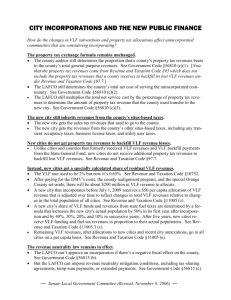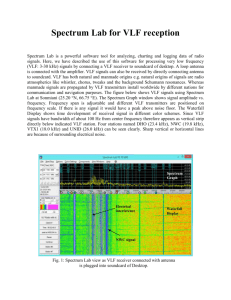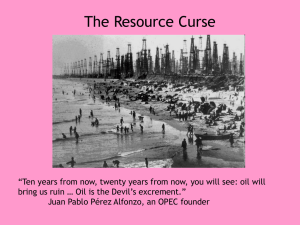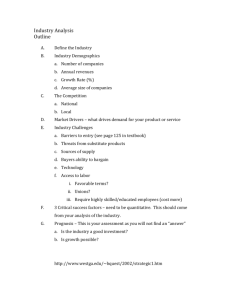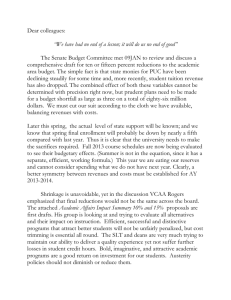City Incorporations and the New Public Finance
advertisement
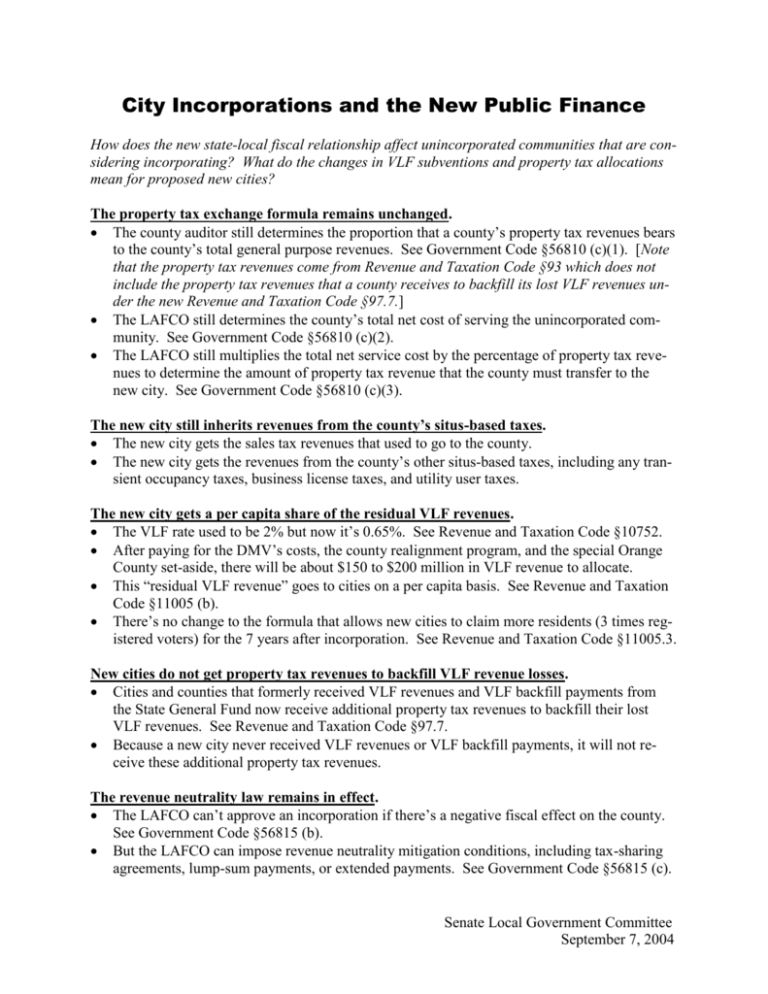
City Incorporations and the New Public Finance How does the new state-local fiscal relationship affect unincorporated communities that are considering incorporating? What do the changes in VLF subventions and property tax allocations mean for proposed new cities? The property tax exchange formula remains unchanged. The county auditor still determines the proportion that a county’s property tax revenues bears to the county’s total general purpose revenues. See Government Code §56810 (c)(1). [Note that the property tax revenues come from Revenue and Taxation Code §93 which does not include the property tax revenues that a county receives to backfill its lost VLF revenues under the new Revenue and Taxation Code §97.7.] The LAFCO still determines the county’s total net cost of serving the unincorporated community. See Government Code §56810 (c)(2). The LAFCO still multiplies the total net service cost by the percentage of property tax revenues to determine the amount of property tax revenue that the county must transfer to the new city. See Government Code §56810 (c)(3). The new city still inherits revenues from the county’s situs-based taxes. The new city gets the sales tax revenues that used to go to the county. The new city gets the revenues from the county’s other situs-based taxes, including any transient occupancy taxes, business license taxes, and utility user taxes. The new city gets a per capita share of the residual VLF revenues. The VLF rate used to be 2% but now it’s 0.65%. See Revenue and Taxation Code §10752. After paying for the DMV’s costs, the county realignment program, and the special Orange County set-aside, there will be about $150 to $200 million in VLF revenue to allocate. This “residual VLF revenue” goes to cities on a per capita basis. See Revenue and Taxation Code §11005 (b). There’s no change to the formula that allows new cities to claim more residents (3 times registered voters) for the 7 years after incorporation. See Revenue and Taxation Code §11005.3. New cities do not get property tax revenues to backfill VLF revenue losses. Cities and counties that formerly received VLF revenues and VLF backfill payments from the State General Fund now receive additional property tax revenues to backfill their lost VLF revenues. See Revenue and Taxation Code §97.7. Because a new city never received VLF revenues or VLF backfill payments, it will not receive these additional property tax revenues. The revenue neutrality law remains in effect. The LAFCO can’t approve an incorporation if there’s a negative fiscal effect on the county. See Government Code §56815 (b). But the LAFCO can impose revenue neutrality mitigation conditions, including tax-sharing agreements, lump-sum payments, or extended payments. See Government Code §56815 (c). Senate Local Government Committee September 7, 2004 City Annexations and the New Public Finance How does the new state-local fiscal relationship affect cities that want to annex more unincorporated territory? What do the changes in VLF subventions and property tax allocations mean for these annexing cities? The property tax exchange negotiations remain unchanged. Local officials can still negotiate an exchange of property tax revenues. See Revenue and Taxation Code §99. Note that the property tax revenues come from Revenue and Taxation Code §93 which does not include the property tax revenues that a county receives to backfill its lost VLF revenues under the new Revenue and Taxation Code §97.7. The annexing city still inherits revenues from the county’s situs-based taxes. The annexing city gets the sales tax revenues that used to go to the county. The annexing city gets the revenues from the county’s other situs-based taxes, including any transient occupancy taxes, business license taxes, and utility user taxes. The annexing city still gets a per capita share of the residual VLF revenues. The VLF rate used to be 2% but now it’s 0.65%. See Revenue and Taxation Code §10752. After paying for the DMV’s costs, the county realignment program, and the special Orange County set-aside, there will be about $150 to $200 million in VLF revenue to allocate. This “residual VLF revenue” goes to cities on a per capita basis. See Revenue and Taxation Code §11005 (b). The annexing city’s VLF revenues will increase if the annexation area is inhabited, or if the annexation area develops and people move in. Annexing cities do not get property tax revenues to backfill VLF revenue losses. Cities and counties that formerly received VLF revenues and VLF backfill payments from the State General Fund now receive additional property tax revenues to backfill their lost VLF revenues. See Revenue and Taxation Code §97.7. Because the annexing city never received VLF revenues or VLF backfill payments from the annexation area, it will not receive these additional property tax revenues. Those revenues stay with the county government. Senate Local Government Committee September 7, 2004
